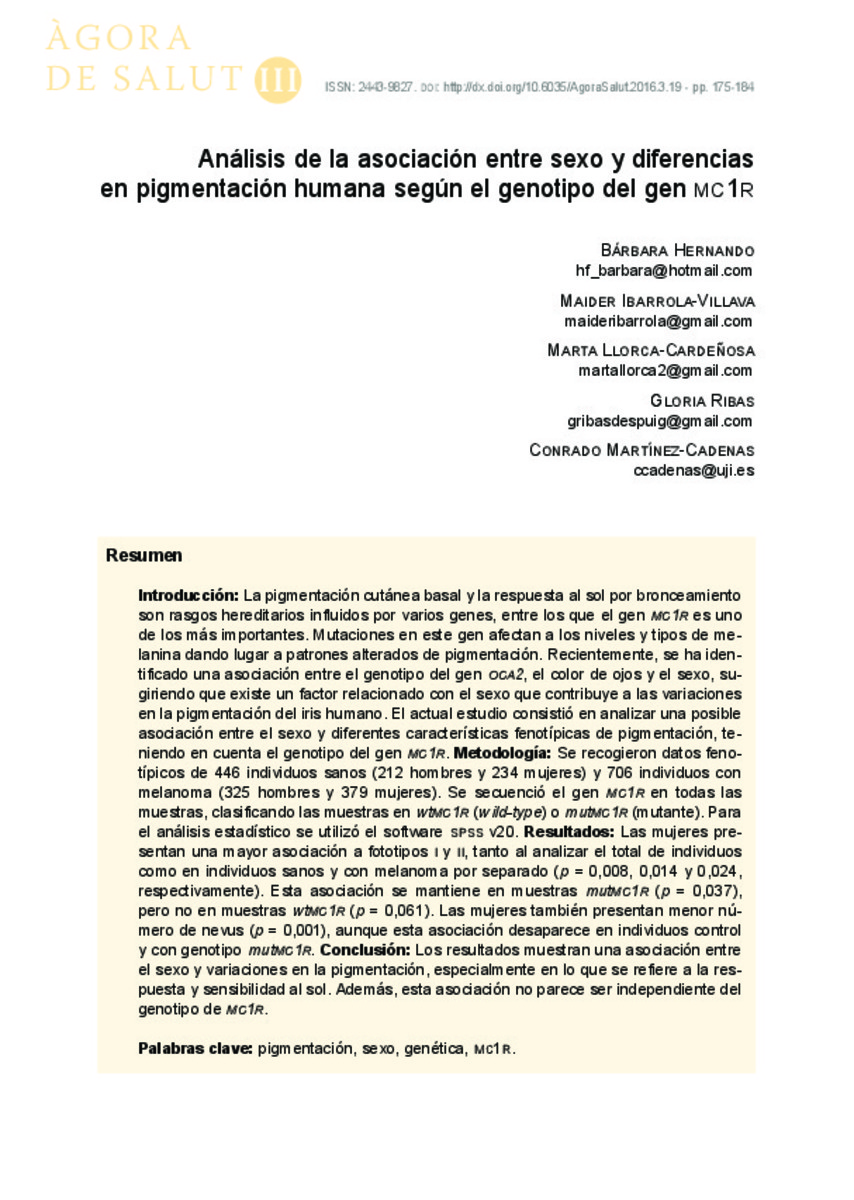Mostrar el registro sencillo del ítem
Análisis de la asociación entre sexo y diferencias en pigmentación humana según el genotipo del gen MC1R
| dc.contributor.author | Hernando, Barbara | |
| dc.contributor.author | Ibarrola-Villava, Maider | |
| dc.contributor.author | Llorca-Cardeñosa, Marta J. | |
| dc.contributor.author | Ribas, Gloria | |
| dc.contributor.author | Martinez-Cadenas, Conrado | |
| dc.date.accessioned | 2016-03-23T12:19:40Z | |
| dc.date.available | 2016-03-23T12:19:40Z | |
| dc.date.issued | 2016 | |
| dc.identifier.issn | 2443-9827 | |
| dc.identifier.uri | http://hdl.handle.net/10234/155146 | |
| dc.description.abstract | Introducción: La pigmentación cutánea basal y la respuesta al sol por bronceamiento son rasgos hereditarios influidos por varios genes, entre los que el gen mc1r es uno de los más importantes. Mutaciones en este gen afectan a los niveles y tipos de me-lanina dando lugar a patrones alterados de pigmentación. Recientemente, se ha iden-tificado una asociación entre el genotipo del gen oca2, el color de ojos y el sexo, su-giriendo que existe un factor relacionado con el sexo que contribuye a las variaciones en la pigmentación del iris humano. El actual estudio consistió en analizar una posible asociación entre el sexo y diferentes características fenotípicas de pigmentación, te-niendo en cuenta el genotipo del gen mc1r. metodología: Se recogieron datos feno-típicos de 446 individuos sanos (212 hombres y 234 mujeres) y 706 individuos con melanoma (325 hombres y 379 mujeres). Se secuenció el gen mc1r en todas las muestras, clasificando las muestras en wtmc1r (wild-type) o mutmc1r (mutante). Para el análisis estadístico se utilizó el software SPSS v20. resultados: Las mujeres pre-sentan una mayor asociación a fototipos i y ii, tanto al analizar el total de individuos como en individuos sanos y con melanoma por separado (p = 0,008, 0,014 y 0,024, respectivamente). Esta asociación se mantiene en muestras mutmc1r (p = 0,037), pero no en muestras wtmc1r (p = 0,061). Las mujeres también presentan menor nú-mero de nevus (p = 0,001), aunque esta asociación desaparece en individuos control y con genotipo mutmc1r. conclusión: Los resultados muestran una asociación entre el sexo y variaciones en la pigmentación, especialmente en lo que se refiere a la res-puesta y sensibilidad al sol. Además, esta asociación no parece ser independiente del genotipo de mc1r | ca_CA |
| dc.description.abstract | Introduction: Basal skin pigmentation and sun-tanning capacity are hereditary traits influenced by several genes, including the mc1r gene. Mutations in this gene affect the levels and types of melanin produced, resulting in altered pigmentation patterns. Re-cently, we have identified an association between oca2 genotype, eye color and sex, suggesting that there is a sex-related factor contributing to changes in iris pigmentation. In this study, we analyzed a possible association between sex and different phenotypic pigmentation characteristics, taking into account the mc1r genotype. methodology: Phe-notypic data of 446 healthy individuals (212 men and 234 women) and 706 patients with melanoma (325 men and 379 women) were collected. The mc1r gene was sequenced in all samples, sorting the samples in wtmc1r (wild-type) or mutmc1r (mutant). For statistical analysis SPSS v20 software was used. results: Women have a greater as-sociation with skin phototypes i and ii, both when analyzing the total sample set as well as healthy and melanoma individuals separately (p = 0,008, 0,014 and 0,024, respec-tively). That association is observed in mutmc1r samples (p = 0,037) but not in wtmc1r samples (p = 0,061). Women also present fewer nevi (p = 0,001), although this asso-ciation disappears in controls and in mutmc1r samples. conclusion: The results show an association between sex and pigmentation variations, particularly with respect to the response and sensitivity to the sun. Moreover, this association does not appear to be independent of the mc1r genotype. | ca_CA |
| dc.format.extent | 10 p. | ca_CA |
| dc.format.mimetype | application/pdf | ca_CA |
| dc.language.iso | spa | ca_CA |
| dc.publisher | Universitat Jaume I | ca_CA |
| dc.relation.isPartOf | Àgora de salut vol. III | ca_CA |
| dc.rights | © Del text: els autors i les autores, 2016 © D’aquesta edició: Publicacions de la Universitat Jaume I, 2016 | ca_CA |
| dc.rights.uri | http://creativecommons.org/licenses/by-sa/4.0/ | * |
| dc.subject | pigmentación | ca_CA |
| dc.subject | sexo | ca_CA |
| dc.subject | genética | ca_CA |
| dc.subject | MC1R | ca_CA |
| dc.subject | pigmentation | ca_CA |
| dc.subject | sex | ca_CA |
| dc.subject | genetics | ca_CA |
| dc.title | Análisis de la asociación entre sexo y diferencias en pigmentación humana según el genotipo del gen MC1R | ca_CA |
| dc.type | info:eu-repo/semantics/article | ca_CA |
| dc.identifier.doi | http://dx.doi.org/10.6035/AgoraSalut.2016.3.19 | |
| dc.rights.accessRights | info:eu-repo/semantics/openAccess | ca_CA |








